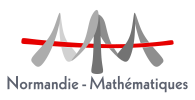 Français
Français English
English
Groups and Intervals in finite fields
Salle de séminaires du LMRS
University of New South Wales, Australia
In 1983, Erdos & Szemeredi proved a remarkable result, nowadays known as the sum-product theorem.
It asserts that a set of integers A cannot simultaneously have a small sum-set $\{a1 + a2 : a_1, a_2 \in A\}$
and a small product-set $\{a_1a_2 : a_1, a_2 \in A\}$. That is, it cannot behave as an arithmetic progression
as well as a geometric progression. Since that time there has been an explosion of work in this direction:
Bourgain–Katz–Tao, Solymosi, Garaev, Rudnev, Konyagin–Shkredov and many others. Similar results
have also been obtained in different settings: complex and real numbers, finite fields, polynomials, etc..
In this talk we mostly discuss the following dual question: How big the intersection of an arithmetic
progression of length $H$ and a geometric progression of length $T$ can be?
We consider this question in the settings of finite fields $F_p$ of $p$ elements, where $p$ is prime.
We outline various results and techniques which have been used in this area, together with a broad range
of applications. These applications span from bounds of exponential and character sums to Fermat quotient
to fixed points of the discrete logarithm, to distribution of g-ary digits in reciprocals of primes, to pseudopowers,
to algorithms. We also discuss several open questions.




